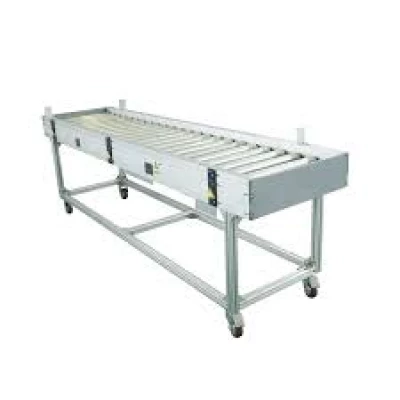Roller conveyors are a series of rollers supported within a frame where objects can be moved either manually, by gravity, or by power.
₹ 60000 /Unit

Get the best quality product from verified sellers
Get pre-negotiated and highly discounted prices for your business
| Brand | Pragati |
|---|---|
| Load Capacity | 50 Kg/Feet |
| Operating speed | 60 m/min |
| Belt material | Ms |
| Power | 1.5 kw |
| Model |
|
Warehousing and Distribution: Gravity roller conveyors are widely used for transporting and accumulating products within warehouses and distribution centers. AC induction motors are ideal for conveyor systems that operate continuously in one direction. For conveyor systems where the load must be held in place or for vertical applications, there are a wide range of AC motors with power-off activated electromagnetic brake.
Gather the proper belt load calculation to prevent applying too much pressure to your conveyor belt system.
Return or Tail Pulley
The tail pulley is situated at the loading end of the Roller belt conveyor. It often has a wing shape to help clean the belt by directing materials away from the support members.
In a basic belt conveyor setup, the tail pulley is typically mounted on guides with slots to adjust the belt’s tension. In other conveyor systems, as we will explore, tensioning is managed by a separate component known as the take-up roller.
Idler Roller
Idler rollers are positioned along the length of the belt to support both the belt and its load, prevent sagging, ensure proper alignment, and remove carryback (material that sticks to the belt).
While idler rollers can perform all of these functions or just one, their primary role in any conveyor system is to support the belt.
| Typical roller sizes and weight carrying capacities | |||||
| Sl. No. | Parameter | Unit | Type of roller | ||
| Medium | Heavy | Extra heavy | |||
| 1 | Roller diameter | mm | 75 | 100 | 150 |
| 2 | Maximum load per roller | kg | 300 | 600 | 1,200 |
| 3 | Axle diameter at the journal | mm | 20 | 30 | 45 |
₹ 70800 (Incl. of all taxes)
₹ 60000 /Unit + ₹ 10800 GST * Freight charges will be extraQty.
To be first to post questions.
Please Login to comment